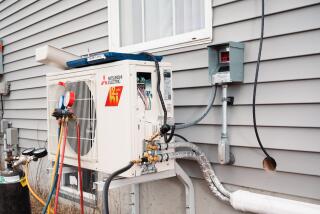Page 2 / News, Trends, Gossip and Stuff To Do : Lifestyle : Getting a Charge Out of Smart Appliances
- Share via
Known for his solar-paneled house and electric car, actor Ed Begley Jr., Hollywood’s premier environmentalist, bought a Staber washer several years ago because it used minimal energy and water. Now he is taking a close look at a range of smaller home appliances with appealingly low appetites for energy. They fall under the expanded Energy Star rating program sponsored by the Department of Energy and the Environmental Protection Agency.
“They now have Energy Star TV sets, tape decks, DVD players and other small appliances,” said Begley, whose own solar-powered house uses only about 100 watts of power each year. Speaking at a news conference to promote the expanded program, he gave an enthusiastic pitch for the Energy Star label: “It’s smart shopping: It means money back in your pocket in the relatively short run. And it means cleaner air in the long run.”
Long aware that the average American home contributes more to air pollution than the average automobile, the two government agencies in 1992 created the Energy Star label, a blue-and-green globe with a gold star, to help shoppers identify the most energy-efficient products on the market.
“We hope the label will become a national icon, like the recycle logo,” said Damon Benedict, spokesperson for the DOE.
Starting with the labeling of computers, the Energy Star program next focused on major appliances, such as furnaces and central air-conditioning units.
“Now we are covering about 25 product categories, including TVs, VCRs, clothes washers, dishwashers and room air-conditioning units,” Benedict said.
By federal law, major appliances are already labeled with a yellow and black EnergyGuide, which estimates annual energy consumption in kilowatt-hours, or kWh, and operating costs. The typical Energy Star product exceeds existing federal efficiency standards by 15%, and for some appliances it can be much more, Benedict said. The program is voluntary for manufacturers and retailers, with about 1,200 manufacturers currently participating, he said.
“Many people don’t realize that such household electronics as televisions and VCRs use energy to maintain memory function and clocks, even when they are switched off,” he said. “Energy Star models cut switched-off energy use by about 70%.”
The typical American household spends $1,300 a year on home energy, and the DOE estimates that Energy Star appliances and equipment could reduce that by up to 40%.
And a household that buys Energy Star equipment instead of standard equipment could prevent the release of 70,000 pounds of carbon dioxide over the life of the products, says the EPA.
*
Information is available at (888) STAR-YES or online at https://www.energystar.gov.
More to Read
Inside the business of entertainment
The Wide Shot brings you news, analysis and insights on everything from streaming wars to production — and what it all means for the future.
You may occasionally receive promotional content from the Los Angeles Times.









